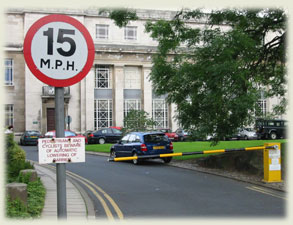
 |
|
  
|
Taxonomy and description
|
| Duration Controls |
| Duration controls relate to the length of time a vehicle can be parked in a public space. The most basic categorisation is long or short stay parking. Short stay spaces (usually less than half a day) are generally nearest to town and city centres and on-street or relatively small ground level car parks. Where demand significantly outstrips supply, parking may be limited to two hours (or as little as 20 minutes), with return prohibited with a specified period (often two hours) and high charges applied. Short stay spaces are most often local authority owned and controlled. Long stay spaces (generally half a day or more) are often on the outskirts of the city centre, off-street and larger (either multistorey or underground) in comparison to short-stay car parks. Duration is controlled through manual enforcement (fines) by the local police, traffic wardens or private companies employed by the local authority. Whether spaces are free or charged, duration controls will only work where drivers perceive the risk of being fined to be high and the fine to be high enough to deter them from ignoring duration restrictions. |
| Time of Day Controls |
| Time of day controls are used to dictate when parking is permitted and when other it is controlled or not permitted. In areas with high traffic flows during the day, on street parking may only be permitted off-peak. It is common for duration controls and charges to be more restrictive during peak hours, and possibly not apply at all during some off-peak hours. Duration controls and charges may apply between 08:00 and 18:00, but not over night for example. Time of day controls are also used to regulate when permits are required. For example, in an inner city residential area, duration and charge controls may apply during the day, but parking is restricted to residents with permits only between 18:00 and 08:00. |
| Supply and location |
| Supply of parking influences the volume of traffic attracted to an area. If drivers cannot be sure of a parking space, they may use a different mode or change destinations. However, limiting supply in popular destination areas may simply increase the amount of traffic searching for parking in that area if parking is not provided elsewhere or alternative modes are not made available. For example, planners may want to keep cars out of city centres to improve the environment for pedestrians (shoppers), so spaces may be taken out of action in the centre, but more provided around the fringes. Use of park and ride may also be encouraged to keep cars out of town completely. Conversely, in areas seeking to make themselves more attractive to visitors, parking supply may be increased. The location of new parking is also important. New parking should be provided in areas where the negative impacts of increased traffic volumes will be least severe, for example near to a main road entering a city, as opposed to residential street locations.
|
| Permits and Dedicated Spaces |
| Permits effectively make parking spaces dedicated to specific users for all or part of a day. They are used to regulate who can park in a space. In residential areas it is common for on-street parking to be for resident permit holders only, although it is possible for local businesses to apply for these permits in some countries. Disabled drivers also hold permits allowing them to deviate from parking controls or use dedicated spaces. Holders of such permits can often park where others are not allowed or in short stay spaces for any duration without a charge. Additionally, large car parks often have dedicated spaces near to payment machines and pedestrian entrances solely for use by disabled drivers. Others who may hold permits allowing them to deviate from parking controls include medical and social services staff who may need to park in residential areas, and trades people who may need to park in residential and commercial areas. Delivery vehicles may also hold permits allowing them to enter controlled zones, even pedestrianised areas, at particular times – often over night. Taxi ranks are also a form of dedicated space. |
| Parking Bans |
Bans are used to prevent on street parking in areas where the road capacity is insufficient to allow parking and maintain traffic flow, or where parking can contribute to accidents. Bans can also be used to tackle parking on footways. Streets and areas subject to parking bans are identified through street markings and traffic signs. On the busiest streets, bans may be complete – i.e. no stopping for any purpose, 24 hours per day. On other streets, bans may be partial – peak hours only for example. The type of ban can also vary; instead of complete bans, stopping to drop off/pick up passengers or goods may be allowed. Parking may also be banned on just one side of a street to provide parking and maintain traffic flow, where the road width is insufficient to allow parking on both sides and cars to pass. As with charges and duration, bans are implemented through enforcement. |
The main focus here is on car parking and the traffic impacts resulting from controls on car parking. Nevertheless, parking controls also relate to coaches, lorries, motorcycles and bicycles. On street controls for coaches, lorries and motorcycles are similar to those for cars, though space requirements and the suitability of parking will differ. Cycle parking and off-street lorry parking are covered separately.
Long stay parking is usually off street and further from destinations, with lower charges the further away from town centres the car parks are. This is designed to keep traffic out of town centres. On street parking is often competed for by different users, and an order or priority for allocation of space is needed. A common source of conflict is between commuters and residents. It is clear that parking policies establishing which type of parking and control is used where and when, must be designed not only to tackle traffic management issues, but also conflicting user needs.
 Technology
Technology
Most forms of parking control now require some level of technological input. Enforcement is usually through the issuing of fines, often via a handheld terminal. These terminals operate on a similar basis to personal digital assistants (PDAs), although they also include portable printers. As with PDAs, the handheld terminals link to office-based PCs to download stored data. Specialised parking management systems are available to operate parking management centrally. These systems control the recovery of fines issued, tow away schemes, the issuing of permits, number and location of spaces (sometimes in real time), and any other aspect of parking management the client specifies for custom built systems. Thus, even uncharged on-street spaces subject only to a duration control require some technology. Where charges are used as a means of control, payment collection technology (on-street meters, in-car meters and smart cards, off-street pay-on-foot kiosks and entry/exit ticket and payment machines) is required. Details of this can be found under Parking Charges.
Technology also has a role in controlling entry and exit to car parks, which can be combined with payment. Off-street parking is often subject to these controls to issue tickets and regulate the volume of search traffic within the car park. Sensors built into ticket machines identify vehicles approaching a barrier or raised bollard, which triggers the issuing of a ticket. When the driver takes the ticket, this raises the barrier or depresses the bollard. The ticket machine then regulates the number of vehicles entering the car park to prevent more cars entering than there are spaces available. On exit from the car park, payment is collected through the same process or a staffed kiosk. The machines are linked to a central computer, which calculates the number of spaces available and stores data on charges received.
 Increasingly,
entry and exit controls merely regulate the number of vehicles within
a car park; payment is by a pay-on-foot machine – drivers obtain
a ticket from a machine located near pedestrian exits as they leave, and
pay at the same machine on return. Tickets are then returned to the driver
who inserts them into an exit control machine to prove that payment has
been made.
Increasingly,
entry and exit controls merely regulate the number of vehicles within
a car park; payment is by a pay-on-foot machine – drivers obtain
a ticket from a machine located near pedestrian exits as they leave, and
pay at the same machine on return. Tickets are then returned to the driver
who inserts them into an exit control machine to prove that payment has
been made.
Increasingly, real time technology also has a role in providing parking
information. It is now common for direction signs to indicate when a car
park is full, and in some cases, which alternative car parks have the
most spaces available. Full details are given under Parking
Information.